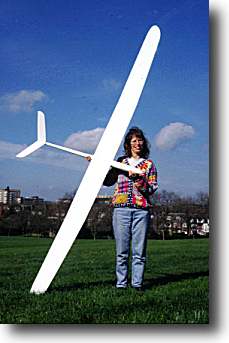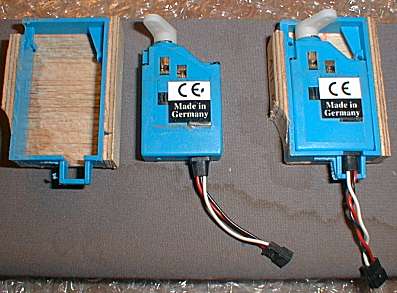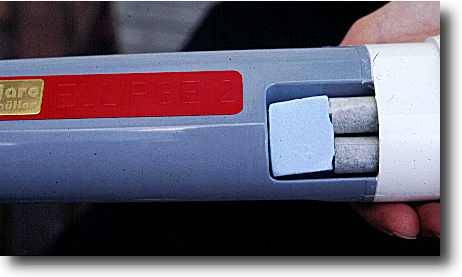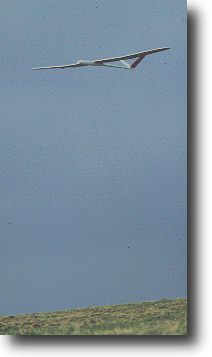Jaro Muller Ellipse 2V
 The Ellipse 2 has been around for some years but it's still popular for F3F. It was therefore the natural choice for me to fly in the 1999 UK F3F league, particularly as spares are readily available.
The Ellipse 2 has been around for some years but it's still popular for F3F. It was therefore the natural choice for me to fly in the 1999 UK F3F league, particularly as spares are readily available.
The V-tail/Carbon variant is ideally suited for F3F. I placed the order with Euromodell and the model arrived on time in a nice big box.
The Bits
Fuselage
Fuselage mouldings are superb. Twin ballast tubes are already fitted. Ballast is loaded cartridge-style through a recess under the radio bay (more convenient than wing-loaded ballast). The V-tail sits on a nicely moulded seat secured by M3 and M1 bolts. Aluminium tube pushrods are supplied with threaded ends.
Wing
The 2.86 m span wing is hollow moulded and suppied as three panels. Section is modified RG15. Surface finish was excellent.
The tips are joined to the centre section with 13 mm square section carbon joiners. Recesses in the wing and fuselage are provided for a pair of D-connectors (supplied). Flaps and ailerons are top-hinged using "living" hinges and moulded shrouds are provided for the pushrods. The wing is attached to the fuselage by two M4 steel bolts.
Intructions
English documentation is sparse. Euromodell provided some extra German instructions. These provide more information about CG and ballast but your German needs to be better than mine to get the most out.
Construction
The model is very easy to build - make sure you have servos which fit the holes and it goes together very quickly indeed. In fact the most time consuming task was threading the radio aerial through the fuselage. I used Volz WingMaxx's in the wing which necessitated a little woodwork.
 The wing servos were mounted in ply boxes which were then epoxied to the wing skin.
The wing servos were mounted in ply boxes which were then epoxied to the wing skin.
CG and Ballast
CG range is 94 – 102 mm. The tubes are positioned so that the CG moves rearward by 6 mm as ballast is added. I know this has puzzled some Ellipse pilots. According to the German instructions this is so that the CG is more likely to track the centre of pressure of the wing (the CP moves back as the angle of attack is reduced during high speed flight). Keeping the CG near the CP minimises the load on the tailplane and hence overall drag.
F3F flyers tend to ignore the aforementioned trim optimisation stuff and simply adjust the CG for a neutrally stable setup and keep it in the same place both with and without ballast. In that case spacers must be used to maintain the chosen CG position. I set my CG at 98 mm and found that a 35 mm balsa spacer behind the ballast did the trick. 5 oz of lead was also needed in the nose.

The ballast slugs were made initially from 15mm diameter copper tube. It looked about right – except the slugs wouldn’t fit!
Eventually I used thin walled brass tubing of the correct diameter as found in the K&C racks in your local model shop.
Now for a major gotcha – make sure that the front ballast retainer is made of something crushable like blue foam – any movement can foul a flange on the inside of the nosecone, thus jamming the nose cone so it can’t be removed (see photo above).
Radio Setup
I used my Multiplex 3030 transmitter with a Futaba 138DF receiver and a 1300 mAH four-cell Nicad pack. Control throws were adjusted roughly according to the instructions.
I used a single memory of my 3030 transmitter to handle all flight modes. This is a pet preference (to avoid having to synchronise adjustments across multiple memories). Here are the main elements of my setup:
- A switch is used to apply three degrees of full span flap for thermalling.
- Three degrees of snap flap for extra lift in high-g turns. Snap flap is automatically disabled when flaps are engaged using the Gx feature on the 3030 transmitter.
- Crow brake can be enabled/disabled by a switch.
- The Limit program on the Tx is used to prevent servo over-travel when full crow and full aileron are applied together, and also for the V-tail servos.
- I use a small amount of aileron->flap mixing.
Flying
Conditions for the first flight at Ivinghoe Beacon were poor with a light Northerly, no matter the model was tossed over the edge all the same. Flaps were engaged for the whole fifteen minutes of the flight, most of it just a few feet above the ridge. Just long enough to show that the handling in light lift is nimble for a largish machine. The model just about stayed up – it couldn’t quite match the stretched Calypso or, ironically, the sole Mini Ellipse, but bearing in mind the greater wing loading, this was a promising start.
 The next session took place in a 12 knot Westerly at the Beacon. This time some mild aerobatics were performed. Stall turns are easy, the rudder function being quite effective at the top of the vertical. Loops are straightforward. Rolls were a bit leisurely and not terribly axial, more setting up and practice would put this right. Inverted flight was undramatic with a little forward stick to hold the nose up. Aerobatics culminated in a couple of inverted stall turns.
The next session took place in a 12 knot Westerly at the Beacon. This time some mild aerobatics were performed. Stall turns are easy, the rudder function being quite effective at the top of the vertical. Loops are straightforward. Rolls were a bit leisurely and not terribly axial, more setting up and practice would put this right. Inverted flight was undramatic with a little forward stick to hold the nose up. Aerobatics culminated in a couple of inverted stall turns.
The third session was at the Bwlch in S. Wales, which was your reviewer’s first BMFA F3F league comp and required, a different approach. For gentle passes, substitute screaming vertical dives followed by fast pullouts to straight and level. Instead of gentle turns, reversals are the order of the day particularly when the lift is good.
The Ellipse is really in its element in this role and with the full 800 gm of ballast and a twenty knot breeze, it’s serious fun. I appreciate the model’s forgiving qualities in these conditions – there was no sign of flicking tendencies even when the elevator stick was being abused in a turn, which is very reassuring and other Ellipse flyers confirm this.
Since then I’ve flown in several further F3F comps. My best time to date is a 36 at the Bwlch. It takes a lot of practice to get the best out of the model – the CG, the snap-flap mixing, elevator movement and roll-rate all have an effect on performance and trying to find that perfect combination for the conditions is a fascinating challenge.
Structurally the model has withstood general use well. The carbon wings are ding resistant, the only problem so far being a very slight crease in the tailplane following a flip over during landing in turbulent air.
Summary
Build quality of the Ellipse is superb as you'd expect from Jaro Muller. Choose the right gear to fit the holes, and assembly is generally a breeze.
While the model once had the F3F field almost to itself, it does now have some genuine competition - the Pike and Acacia spring to mind. Nevertheless, it's still up there - a fast, competitive machine whose main strength is its docile handling and ready availability of spares.
Postscript (Feb 2001)
I've now retired my two Ellipse 2V's in favour of the Acacia Mk 1. This is a gamble - the Acacia is maybe a fraction faster but spares are not readily available. Even in 2001 the E2V is still a very capable aircraft, and I shall be keeping one in reserve.
The only problem has been a tendency for the V-tail to rock on its platform after a time, because of deformation of the skin due to flight and landing loads. This can be cured by packing the underside with epoxy/micro-balloons. To prevent the epoxy from sticking to the fuselage, make a thick paste and smear some vaseline on the fuselage seating before screwing the V-tail in place, then wait for the paste to set.
Technical Data
- Span: 2860 mm / 9ft 5in
- Length of fuselage: 1413 mm / 4ft 6in
- Wing area 60.6 dm2 / 6.5 sq ft
- Aspect ratio: 13.6
- Profile: RG 15 mod.
- Projected tail area 6.0 dm2 / 0.65 sq ft
- Weight: 2250 gm / 5 LB
- Ballast: 800 gm / 1.75 LB
- Wing loading: 36-56 g/dm2 / 12 – 17 oz/sq ft
Contacts
Europe
EUROMODELL + D- 66822 Lebach + Galgenheck 20
Phone: +49 6881 / 88795
Fax: +49 6881 / 53650
http://www.euromodell.de
Related Articles in RC-SOAR.com
- Ellipse 2 Ellipse 2V - Development History.
- Ellipse 2 - a Sport Flyer's View by Jim Chambers.
- Ellipse 2 Building Notes by John Wheatley
